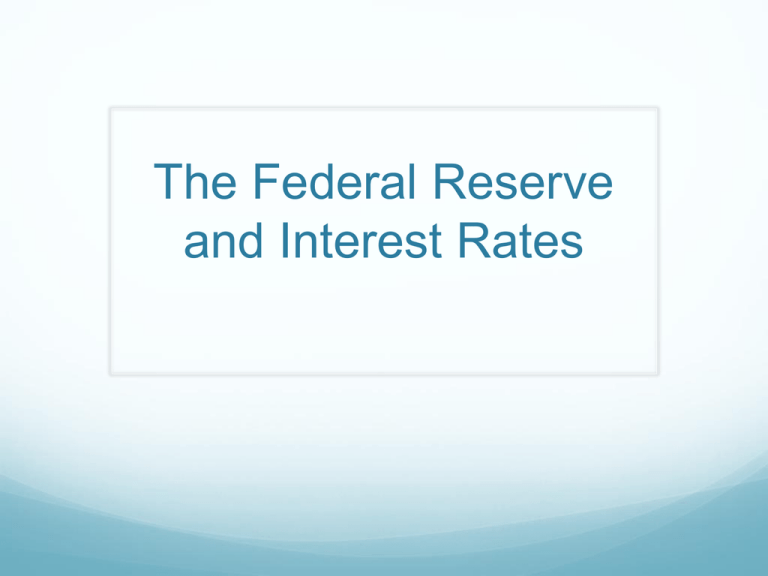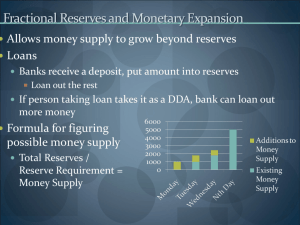Federal Reserve
advertisement

The Federal Reserve and Interest Rates GDP Review What is GDP how is it calculated? National consumption = National Income GDP = C (consumption)+I (investment) +G (government) +NX (Net Exports) What is Keynesian Fiscal Policy during a recession? Spend more government $$$ or cut taxes to attempt to keep GDP constant Objectives describe the relationship between bank reserves, interest rates, and the economic goals of maximum employment and price stability describe the key components of the Federal Reserve’s dual mandate identify the ways in which monetary policy tools can be used to achieve economic objectives Who has a savings or checking account? What do banks do with your deposits? Why do you put money in these accounts? Why do banks exist? How do they make money? Banks make loans to earn profits. pay depositors interest for their deposits lend to borrowers at a higher interest rate then they pay on deposits trying to earning profit. Image from NYT Banks Functions and Regulations • Deposit- money placed in a bank account • Bank reserves – The sum of cash that banks hold in their vaults in Cash • Required reserves – The percentage of deposits that FDIC insured banks must hold in cash reserve • Excess reserves – A banks actual reserve minus required reserves • This is what banks can loan out to other people Excess Reserve Example Wells Fargo has 100 customers with 10 dollars each. What is the total value of the deposits? $1000 Wells Fargo has $500 dollars in their bank account in Cash. What is the value of their bank reserves? $500 Wells Fargo has a required reserve rate of 10% What are their required reserves? $100 What is the value of Wells Fargo’s excess reserves Total reserves- Required Reserves = excess reserves $500- $100= $400 What would happen if a bank wanted to make a loan but did not have enough excess reserves to do so? Federal Funds Market Banks might want to make a loan they think will be profitable. If they do not have enough excess reserves to make the loan they can choose to borrow excess reserves from another bank in the federal funds market. Federal funds market – The market in which banks can borrow or lend reserves from other banks allowing banks temporarily short of their required reserves to borrow from banks that have excess reserves. Why would banks loan their money to another bank? Like any loan, in exchange for interest Federal funds rate – The interest rate at which a bank lends funds that are immediately available to another depository institution overnight. The Federal Reserve System Banks can also borrow reserves from our central bank Federal Reserve System also called the Federal Reserve or simply the Fed The Fed is known as the “lender of last resort” because banks can borrow from the Fed when other funding sources might not be available. The Federal Reserve System The discount rate is the interest rate charged by the Federal Reserve to banks for loans. The federal funds rate is usually lower than the discount rate, so it is in banks’ financial interests to borrow from other banks instead of the Fed. By changing the discount rate, the Fed can influence other interest rates—for this reason, the discount rate is regarded as a “tool” the Fed to influence the economy. Monetary policy- consists of the actions of a central bank to influence the cost and availability of money and credit to achieve the national economic goals. This is different than Fiscal policy the responsibility of Congress and the White House, enacted through changes in government spending and taxes. If the demand for apples were to stay the same, but the number of apples that growers had available doubled, what would happen to the price of apples? The price would decrease If the demand for apples were to stay the same, but the supply of apples were reduced by half, what would happen to the price of apples? The price would increase Interest Rates Interest rates (like other prices) fluctuate. One factor affecting the price of a good is its supply. Interest – The price of using someone else's money. Bank Reserves are the supply of money that can be lent out Interest Rates If the supply of reserves increases interest rates will decrease. If the supply of reserves decreases interest rates will increase. The Fed uses open market operations to influence the supply of reserves, therefore interest rate. Open market operations - the buying and selling of government bonds by the Federal Reserve in order to influence the supply of reserves in the banking system. Open market operations are an important monetary policy tool. The Fed’s Dual Mandate The Fed’s responsibility is to use monetary policy to promote maximum employment and price stability. Price stability – A low and stable rate of inflation maintained over an extended period of time. The Fed has a longer-run goal of 2 percent inflation. Maximum employment – The Fed does not have a specific unemployment target regularly publishes its forecast for the longer-run rate of unemployment. Questions What would happened to the level of reserves in the banking system if the Fed purchases government bonds from banks? What likely happens to interest rates when more excess reserves are available for loans in the banking system? How will consumers and businesses likely respond? How will producers respond? The Fed’s Toolbox Slide 6: Expansionary Policy Money Primary Federal Dealers Reserve Fed Buys Bonds Investors Banks Bank Reserves Increase Bonds Expansionary monetary policy – Actions taken by the Federal Reserve to increase the growth of the money supply and the amount of credit available. Interest Rates Decrease Borrowing Increases Questions What would happened to the level of reserves in the banking system if the Fed sells government Bonds? What likely happens to interest rates when more excess reserves are available for loans in the banking system? How will consumers and businesses likely respond? How will producers respond? The Fed’s Toolbox Slide 7: Contractionary Policy Bonds Primary Federal Fed Sells Bonds Dealers Reserve Investors Banks Bank Reserves Decrease Money Contractionary monetary policy – Actions taken by the Federal Reserve to decrease the growth of the money supply and the amount of credit available. Interest Rates Increase Borrowing Decreases Monetary Policy The Federal Reserve as 4 major Monetary Policy tools at its disposal • Discount rate – The interest rate charged by the Federal Reserve to banks for loans obtained through the Fed's discount window. • Open market operations – The buying and selling of government securities through primary dealers by the Federal Reserve in order to control the money supply. • Reserve requirements – Funds that banks must hold in cash, either in their vaults or on deposit at a Federal Reserve Bank. (last changed in 1992) • Interest on reserves – Interest paid by Federal Reserve Banks on required and excess reserves held by banks at Federal Reserve Banks. Headline: Unemployment Soars While Deflation Fears Grow What should the Fed do? Headline: Prices Rising: Inflation Worries Grow What should the Fed do? NPR on Monetary vs Fiscal Keynes Versus Hayek Round 2 Video Review on Monetary Versus Fiscal








